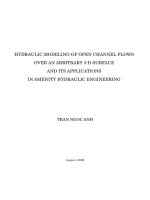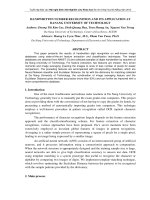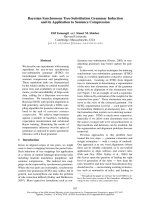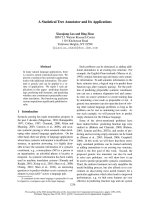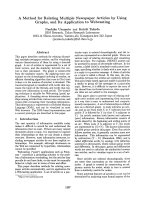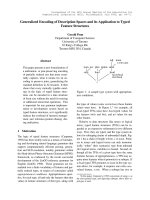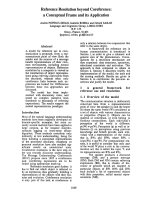DIFFERNTIABLE ITS APPLICATION
Bạn đang xem bản rút gọn của tài liệu. Xem và tải ngay bản đầy đủ của tài liệu tại đây (458.96 KB, 36 trang )
THAI NGUYEN UNIVERSITY OF EDUCATION
MATHEMATICS
----------
PROBLEM SEMINAR
PROBLEM: DIFFERNTIABLE & ITS APPLICATION
Supervisors: Ph.D NGUYEN VAN THIN
Author:
NGUYEN NHU QUYNH
Class:
MATHEMATICAL ANALYSIS I
June, 2022
CONTENTS
INTRODUCTION
Derivatives are a very important concept in mathematical analysis and have
many applications in other sciences such as economics, mechanics, physics, and
engineering. Even in mathematics, the derivative is an important factor, applied to
solving problems in algebra, calculus or problems in geometry that we often
encounter in national math competitions and national math Olympiads economic.
In the high school math program, the content of derivatives and the
application of derivatives play a key role, occupying a large amount of knowledge
and learning time of the program. Making students master the subject knowledge
of derivatives is the basis for them to effectively study many content knowledges
of math and some other subjects. Therefore, in teaching, teachers need to
determine to improve the teaching quality of the content of the topic of derivatives,
both as a goal and as a necessary condition for the performance of the task of
teaching the subject.
The application of derivatives both has the effect of reviewing and
systematizing knowledge, as well as affirming the practicality of knowledge
content. Teaching applications of derivatives is an opportunity to develop
functional thinking for students. If this skill is practiced, students will not only
master the mathematical knowledge system, but also contribute to training math
problem solving skills, skills to apply math knowledge to practice, and developing
math thinking for students. With that in mind, my group's essay presents the topic:
"Differentials and applications".
Although our group has made a lot of efforts, but due to limited time and
capacity, it is inevitable that we will have shortcomings. We hope to receive your
constructive advice. We sincerely thank you!
2
CHAPTER I. BASIC CONCEPTS OF DERIVATIVES
1.1. Derivative at a point.
Definition:
Let the function y = f(x) be determined on the interval (a, b) and x 0(a,b). If there is
a limit (finite)
=
Then the limit is called the derivative of the function y= f(x) at x 0 and denoted by
f’(x0) (or y’(x0)).
f’(x0) =
Example: Compute the following derivative y = cosx at x0=
Solution:
y = cos ( - ) - cos
= -2sin ( + ). sin
=
y’() =
= -.
= -sin =
1.2. One-sided derivative.
Definition: Let the function y=f(x) be determined on the interval ) (or ) and x 0 ). We
say that the function has a right derivative (or left derivative) finite at x 0 if it there
exists a finite limit
(or )
We will call that the value of limit is right derivative (or left derivative) of the
function at x0 and denoted by f’(x0).
3
Theorem (Relationship between derivative and one-sided derivative):
So that the function f(x0) has a derivative at x0 the necessary and sufficient
condition is that the function has the right derivative equal to the left derivative at
that point. In that case, we have:
f’(x0) = f’+(x0) = f’-(x0)
Proof:
The function has derivative at x0:
f’(x0) ∃ = f’(x0)
∃ f’+(x0) = =
= f’ - (x0)
Therefore, f’(x0) = f’ + (x0) = f’ - (x0)
1.3. Derivative over an interval.
Definition:
The function y = f(x) is called the derivative over an interval (a, b) if it has
derivative at all point on over an interval.
The function y = f(x) is said to have derivative on the over an interval if it has
derivative on the interval (a, b) and it has the right derivative at a and the left
derivative at b.
Example: Compute the following derivative:
y (x) =
Solution:
With : y’(x) = -1
With : y’(x) =
= (2 – 3x + )’
= 2x - 3
With : y’(x) = 1
4
Compute the following derivative at x=1 and x=2, we have:
y’-(1) = = -1
y’+(1) = = = -1
Hence, y’(1) = y’-(1) = y’+(1) = -1
The same prove: y’(2) = y’-(2) = y’+(2) = 1
Therefore y’(x) =
1.4. The relationship between the existence of the derivative and the continuity
of the function.
If the function y=f(x) has a derivative at the point , then it is continuous at that
point.
f(x) has a derivative at -> f(x) is continuous at
Prove
Assuming that f(x) has a finite derivative f’(at , there is a finite limit
= f’(
According to the theorem, there exists a neighborhood of such that:
C in that neighborhood, where C is a constant.
From there, = C. Moving to the limit when ∆x we have =0. So, the function is
continuous at .
• Note:
+) Continuous function at a point is not sure derivative at that point.
+) Similarly, we state the theorem about the relationship between one-sided
continuity and one-sided derivative.
1.5. Math in the derivative.
1.5.1- Derivative of sum, difference, product, quotient.
Suppose u(x), v(x) are functions with derivatives at x. Then their sum, difference,
product, quotient (non-zero denominator) is also the derivative and
(u + v)’ = u’ + v’
5
(u - v)’= u’ - v’
(u.v)’ = u’v + uv’
()’=
Prove
1) Let x be the increment ∆x. The corresponding increment of u is ∆u, of v is ∆v
and of y= u + v is ∆y. We have:
= ∆u + ∆v
Make a score = +
Find the limit: = +
Thus, (u + v)’ = u’ + v’
2) Similar proof we have: (u-v)’= u’-v’
3) Let x increment ∆x. The corresponding increment of u is ∆u, of v is ∆v and of y
is ∆y. We have:
∆y= (u + ∆u).(v + ∆v) - u.v
= u.v + v.∆u + u.∆v + ∆u.∆v - u.v
= (∆u).v + u.( ∆v) + (∆u. ∆v)
Make a score = + .
Find the limit
= + )+
Under the assumption that v has a derivative so v continuous and therefore
On the other hand =v’
Thus y’= u’.v + u’.0+u.v’= u’v + uv’
->(u.v)’ = u’v + uv’
6
4) Let x be the increment ∆x. The corresponding increment of u is ∆u, of v is ∆v.
Since v(x) ∆x is small enough, then v+∆v The corresponding increment of y= is
We have:
∆y= Make a score: =
Find the limit
= =
Therefore,
Example 1: Calculate the derivative of the function ln (x+)
Solution.
We have: y’= . (x+)
= (1+
=
Therefore, (ln (x+))’ =
Example 2: Calculate the derivative of the function
Y=
To make it easier to calculate, we assume that the factors in the expression of the
function can be logarithmic, then:
ln y = 3ln(2x-1) + – 2ln(5x+4) - .ln(1-x)
= .2 +.3 – 2..
Hence:
y’ =
That is also the expression of the derivative y’ to find.
1.5.2. Derivative of the composite function.
Theorem: If the function u=g(x) has derivatives with respect to x, and the function
y=f(u) has derivative with respect to u, then the composite function y=f[g(x)] has
derivatives with respect x and we have:
7
y’x = y’u.u’x
Prove
Let x increment ∆x. The corresponding increment of u is ∆u. With that increment
of u, y=f(x) has a corresponding increment of ∆y.
Make a score = (hypothesis ∆u
Find the limit: =
Hypothetically when ∆x0, thus ∆u= .0=0.
On the other hand, under the assumption that y has a derivative with respect to u,
so when ∆u0.
Therefore, = . =
1.5.3- Derivative of the inverse function.
Theorem: If the function y=f(x) has a derivative y’ at x and has an inverse x=g(y),
the inverse function has a derivative at y and we have:
=
Prove:
Give y the increments The corresponding increment of x=g(y) is . Note that if
then and otherwise, then
(x+-f(x)= f(x)-f(x)=0
So, we can write
Since the function y=f(x) has a derivative at x, it is continuous there. Then it
follows that the inverse function x=g(y) is continuous at y and ∆x0 when ∆y0.
Therefore, = =
1.6- Derivative of elementary functions.
We summarize the basic elementary derivative calculation formula (learned in
grade 12) in the following table:
8
1.7. Senior Derivatives.
Definition: Assume the function f(x) has a derivative in the interval (a,b) and
assume that its derivative at x is f’(x). This derivative can have a derivative again.
If so, the derivative f’(x) is called the second derivative of f(x) and is denoted by
f’’(x).
9
Similarly, the derivative of f’’(x) (if any) is called the third derivative of f(x) and is
denoted by f’’’(x)…
In general, the derivative of is called the n-order derivative of f(x) and is denoted
by
[
1.8. Meaning of derivative.
1.8.1. Geometric meaning.
For a function y=f(x) defined on (a, b) and derivative at . Let (C) be the graph of
that function. The derivative of the function y=f(x) at the point is the slope of the
tangent T to (C) at the point M (
1.8.2. Physical meaning.
• Transportation time
Instantaneous velocity is the derivative of position with respect to time.
Consider the linear motion defined by the equation s=s(t) where s=s(t) is a function
with derivatives. The instantaneous velocity of the motion at time is the derivative
of the function s=s(t) at : v (
• Instant intensity
If the amperage Q transmitted in the conductor is a function of time: Q=Q(t) where
Q=Q(t) is a function with derivative, then the instantaneous magnitude of the
current at time is the derivative of the function Q=Q(t) at I (Q’ (
1.8.3- The mechanical meaning of the second derivative.
The second derivative f’’(t) is the instantaneous acceleration of the motion s=f(t) at
time t. Consider the motion defined by the equation s=f(t), where s=s(t) is a
function with derivatives to the second order. The instantaneous velocity at t of the
motion is v(t)=f’(t). Taking the increment ∆t at t, then v(t) has the corresponding
increment ∆v. If v’(t) = = , we call v’(t) = the instantaneous acceleration of the
motion at time t. Because v’(t) = should =f’’(t).
10
CHAPTER 2 : THE MEAN VALUE THEOREM
1. Fermat’s theorem:
Suppose f is defined in a full neighborhood of a point x 0 and differentiable at x0. If
x0 is an extremum point, then it is critical for f, i.e.,
f’ (x0) = 0.
Proof.
To fix ideas, assume x0 is a relative maximum point and that Ir (x0) is a
neighborhood where f(x) ≤ f(x0) for all x∈Ir (x0). On such neighborhood then ∆f =
f(x) – f(x0) ≤ 0.
If x > x0, hence ∆x = x – x0 > 0, the difference quotient is non-positive. This
implies
Vice versa, if x < x0, i.e, ∆x = x – x0 < 0, then is non-negative, so
Hence,
f'(x0) = = ,
so f'(x0) is simultaneously ≤ 0 and ≥ 0, hence zero.
A similar argument holds for relative minima.
2. Rolle’s Theorem
Let f be a function defined on a closed bounded interval [a, b], continuous on [a, b]
and differentiable on (a, b) (at least). If f(a) = f(b), there exists an x0 ∈ (a, b) such
that
f'(x0) = 0.
In other words, f admits at least one critical point in (a, b).
11
Rolle’s Theorem
Proof.
By the Theorem of Weierstrass the range f ([a, b]) is the closed interval [m, M]
bounded by the minimum and maximum values m, M of the map:
for suitable xm, xM ∈ [a, b].
In case m = M, f is constant on [a, b], so in particular f'(x) = 0 for any x ∈ (a, b)
and the theorem follows.
Suppose then m < M. Since m ≤ f(a) = f(b) ≤ M, one of the strict inequalities f(a) =
f(b) < M, m < f(a) = f(b) will hold.
If f(a) = f(b) < M, the absolute maximum point xM cannot be a nor b; thus,
xM ∈ (a, b) is an interior extremum point at which f is differentiable.
By Fermat's Theorem, we have that xM = x0 is a critical point. If m < f(a) = f(b),
one proves analogously that xm is the critical point x0 of the claim.
•
The meaning geometric
In the given graph, the curve y = f(x) is continuous between x = a and x = b and at
every point, within the interval, it is possible to draw a tangent and ordinates
corresponding to the abscissa and are equal then there exists at least one tangent to
the curve which is parallel to the x-axis. Algebraically, this theorem tells us that if f
(x) is representing a polynomial function in x and the two roots of the equation
f(x) = 0 are x = a and x = b, then there exists at least one root of the equation
f’(x) = 0 lying between these values. The converse of Rolle’s theorem is not true
and it is also possible that there exists more than one value of x, for which the
12
theorem holds good but there is a definite chance of the existence of one such
value.
3. Mean Value Theorem or Lagrange Theorem
Let f be defined on the closed and bounded interval [a, b], continuous on [a, b] and
differentiable (at least) on (a, b). Then there is a point x0 ∈(a, b) such that
f’(x0).
Every such point x0 we shall call Lagrange point for f in (a, b).
Proof.
Introduce an auxiliary map
defined on [a, b]. It is continuous on [a, b] and differentiable on (a, b), as difference
of f and an affine map, which is differentiable on all of R. Note
It is easily seen that
g(a) = f(a),
g(b)=f(a),
so Rolle's Theorem applies to g, with the consequence that there is a point
x0 ∈ (a, b) satisfying
13
Lagrange point for f in (a, b)
•
The meaning geometric of the Mean Value Theorem is clarified on the figure
above. At each Lagrange point, the tangent to the graph of f is parallel to the
secant line passing through the points (a, f(a)) and (b, f(b)).
4. Cauchy’s Theorem
Let f(x), g(x) be functions defined, continuous an a closed bounded interval [a, b]
and g(a) ≠ g(b); assume f(x) and g(x) are differentiable on open interval (a, b) and
g’(x) ≠ 0 for all x ∈ (a, b). There exists x0 ∈ (a, b) such that
Proof.
We first assume that the function of satisfies the assumptions of Lagrange’s
theorem. Then there exists a point c ∈ (a, b) so that
Because g’(c) ≠ 0, it follows form that g(b) – g(a) ≠ 0.
Consider the function
ϕ ,
x ∈ [a, b]
ϕ satisfies the continuous of Rolle’ theorem:
•
ϕ is continuous on closed interval [a, b]
ϕ has a derivative on the interval (a, b):
•
ϕ(a) = ϕ(b) = 0.
•
Hence there exists at least one point x0 ∈ (a, b) so that ϕ’(c) = 0.
From that, deduce the equality to be proved.
14
5. Applications
5.1. Prove the existence of a solution of the equation
Problem: Let m > 0, a, b, c sastify
Prove that the equation ax2 + bx + c = 0 has a solution in the interval (0; 1).
Solution:
The function
F(x) =
continuous on [0; 1] with a derivative on (0; 1) and F(0) = F(1) = 0 there
exists x0 ∈ (0; 1) such that
F’(x0) = xm – 1(ax02 + bx0 + c) = 0
Hence, ax02 + bx0 + c = 0.
5.2. Applications in solving equations
Problem: Solve the equation
5 x + 12 x = 6 x + 11x
(*)
Solution:
Rewrite the given equation in the form
12 x − 11x = 6 x − 5 x
Assuming the equation has a solution
α
then
12α − 11α = 6α − 5α
(**)
f (t ) = (t + 1) − t
f (t )
Consider the function
(t > 0).
is continuous and has a
f ′ ( t ) = α (t + 1)α −1 − t α −1
(0; +∞)
derivative on
and
∃ c ∈ ( 5;11)
On the other hand, from (*) we have. So by Rolle's theorem
α
such that
f ′(c ) = 0
15
α
α −1
⇒α
− cα −1
(c+ 1)
=0
α = 0
α = 0
⇒
⇒
α −1
α −1
=c
α = 1
(c + 1)
α = 0, α = 1
Try again, we see the values
that satisfy the equation (*).
This method gives 2 solutions x=1 and x=0
5.3. Application to prove inequality
Problem:
Prove:
∀x ∈ (0, +∞)
Solution:
We have
Let f(x) = x
We get:
Apply Lagrange’s theorem to the function
y = ln t on [x, x+1] then there exists c ∈ (x, x+1) such that
But 0 < x < c < x + 1
⇒
⇒
⇒ f’(x) > 0,
∀x ∈ (0, +∞)
The function f(x) is convariant on (0, +∞).
Hence, f(x+1) > f(x), ∀x ∈ (0, +∞).
16
CHAPTER 3: TAYLOR EXPANSION AND APPLICATION
1. Taylor expansion for polynomials:
Consider polynomials P(x) = anxn + an-1xn-1 + …+ a1x + a0 , then with any point xo
we have:
2. Taylor expansion for any function
2.1. Taylor expansion with Peano form remainders:
Assuming the fuction f(x) has derivative to degree n in the neighborhood
(x0 - δ; x0 + δ) of x0. Then:
The above fomular is called the Taylor expansion of the fuction f(x) to degree n at
the point xo with Peano form remainders:
2.2. Mac-Laurin expansion:
In fomular Taylor expansion with a peano residual when ,we have:
This formula is called the Mac–Laurin expansion formula
2.3. Taylor expansion with Lagrange remainders
Assume the function
has derivative to dgree n+1 in neighborhood
(x0 - δ; x0 + δ) of x0. Then:
Where c is a point between x and x0
The above formula is called the Taylor expansion of the function f(x) to degree n at
point x0 with Lagrange remainders.
3. Mac-Laurin expansion of some commonly used elementary fuctions
*
17
*
Then
*
Then
*
Then
*
Then
*
*
4. Taylor expansion application to calculate the limit of the function:
Example: Find the real number a such that
Solution. Applying L’hopital, we have:
So,
5. Apply Taylor expansion to calculate the higher order derivative at the point
x=0
Example: Mac-Laurin expansion of the function then calculate the derivative
Solution. Applying the fomular
Therefore
18
6. Application of Taylor expansion with Lagrange residuals approximates the
value of expression:
Example: Taylor expansion of the function up to level to at x= 31, then calculate
and error assessment.
Solution. We expand with Lagrange remainders:
So,
The error assessment is
7. Application of taylor expansion to other forms of math
Example 1: Let function f(x) be define and has a continuous second derivative on
the [0;1] such that satisfied f(0) = f(1) and . Prove that
Solution. Taylor expansion with Lagrange residuals has:
With a is a real number between 0 and x, b is the real number between 1 and x
Combined hypothesis, we get:
Thus,
Example 2: Let be a function that is 2 times differentiable for all x belongs to
[0;1] then . Prove that
Solution. Applying Taylor expansion at , we have:
19
Adding the two sides of the above equation, we get
Example 3: Let
Prove that
be level 2 differentiable on [0;1] and satisfied f(0)=f(1)= a and .
Solution.
Because f is continuous on [0;1] then there exists
. By Fermat’s Theorem, thus . Using Taylor expansion, we have:
such that
Example 4: Let be a differentiable function with a positive second derivative.
Prove that
Solution. Using Taylor expansion at , we get:
This implies
Therefore, this problem is complete.
CHAPTER 4: L’ HOSPITAL’S RULE
Defintion 1:
For two function f(x) and g(x) , if :
(a) = g(a) = 0
Then
Proof:
From the hypothetical g(x) ,
apply cauchy's theorem (a) = g(a) = 0 ) we have:
= =
(1)
20
c is a point between a and x
When x then c and = A
From (1) = A
Definition 2:
Suppose = = 0 and big enough two function , g(x) all of them are possible and
g’(x) . Then (Finite or infinite)
Hence,
Definition 3: Suppose there exists , g’(x) (g’(x)), ( , x )
=,
=
= A.
Then = A
Attention:
If = + then has at least 1 neighborhood of point a
Then we get :
=0
(1)
Following definition ,from (1) we have :
= 0 or
Note:
Indeterminate forms 0. and - . To eliminate these indeterminate forms by an
algebraic transformation we return to the form or and then apply l'hopital
rule.
2. Indeterminate reduction form 1 , 1, 0. Following logarithmic operation, we
return to the form 0..
3.L’hopital Rule uses a lot of derivatives, so it is necessary to remember all the
rules for calculating derivatives of functions.
1.
21
CHAPTER 5:
CONCAVE DOWNWARD & UPWARD AND INFLECTION POINT
1. Concepts on concave downward , concave upward of the cave and inflection
point.
a. Concepts on concave downward, concave upward
Assume taht y = f(x) is a differentiable function whose gragh is a curve (c)
Defintion: A curve (c) is said to be concave downward (or convex) at the point x 0
if in some neighborhood of x0 to ( c). Curve (c ) is said to be concave upward (foe
concave) at x0 every point of line ( c) lies on the tangent at x0.
A curve is said to be concave downward or concave upward in the interval if it is
concave downward or concave upward at every point of the interval.
b. Inflection points
Definition: The point which concave upward arc is called the inflection point of
the
gragh.
Note: At inflection point , the tangent goes through the gragh.
22
So, C is an inflection point.
2. Signs of concave downward , concave upward and inflection point
Theorem 1 : let y = f(x) be the function which has the second derivative on the
interval (a,b).
(1)
If F’’(x) < 0 for any x (a;b), then the gragh of function is concave downward
on the interval.
x
f’’(x)
y = f(x)
(2)
a
b
Concave downward
If f’’(x) > 0 for any x (a;b), then the gragh of function is concave upward on
the interval.
x
f’’(x)
y = f(x)
a
b
+
Concave upward
Proof:
Assume that x0 (a;b). By expanding Taylor function y = f(x) in the neighborhood
of x0 , we get :
23
y = f(x) =f(x0) + f’(x0)(x-x0) + where
Let y be the coordinate of the point with coordinate x on the tangent to the line
y = f(x) at x0, we have :
y = f(x0) + f’(x0)(x-x0)
Hence : y – y = (
If f’’(x) < 0 , we have y < y’ ,that is in the neighborhood of x 0 the curve is below
the tangent , the curve is concave upward.
+) Geometric meaning: If f’’(x) < 0 , f’(x) is decreasing that is the slope of the
tangent to the curve decreased, the curve is concave downward, similarly if the
slope of the tangent to the curve increase, the curve is concave upward.
Theorem 2: Let y = f(x) be the function which has the second derivative on the
interval (a,b) and x0 (a;b). If f’’(x) changes its sign when x goes through x 0 , then
the point M0 (x0; f(x0)) is an inflection on point of the gragh of the given function .
Illustrative examples
Example 1: Using Taylor expansion, calculate the following limit:a)
1
L1 = lim x − x2 ln(1+ )
x→∞
x
Solution: We have
1 1 1
1
ln(1+ ) = − 2 + 0( 3 ), (x → +∞)
x x 2x
x
24
1
1
1
1 1
⇒ x − x2 ln(1+ )x + x2 ln(1+ ) = x − x2 − 2 + 0( 3 )
x
x
x
x 2x
1
1
= + 0( )
2
x
Thus
1
1 1
1
lim x − x2 ln(1+ ) = lim + 0( ) =
x→∞
x x→∞ 2
x 2
arcsin x − sin x
x→ 0 ex + ln(1− x) − 1
L2 = lim
b)
Solution: Expand to x3 because the numerator only needs to be x3 to be non-zero
We have
1
1
1
arcsin x − sin x = x + x3 + O(x3 ) ÷− x − x3 + O(x3 ) ÷ : x3
6
6
3
1
1
1
1
ex + ln(1− x) − 1 = 1+ x + x2 + x3 + O(x3) ÷+ (− x) − (− x)2 + (− x)3 + O(x3) ÷− 1
2
6
2
3
1
≈ − x3
6
1/ 3x3
= −2
x→ 0 −1/ 6x3
L2 = lim
Thus
Example 2: Suppose
x > 0, k = 1,2,....
f (x) ∈ C∞ (R), f (k) (0) = 0 ∀k=0,1,2....
Prove that
f (x) = 0
with
and
f (k) (x) ≥ 0
with
x> 0
Solution: Taylor expansion of the function
f (0) = 0 ∀k ∈ N
k
25
f (x)
with
x = 0, x > 0
noti
